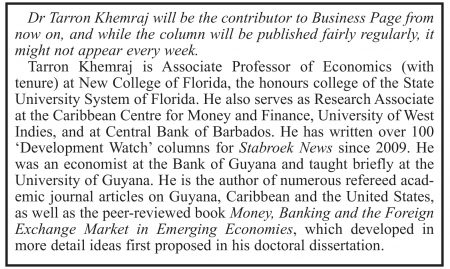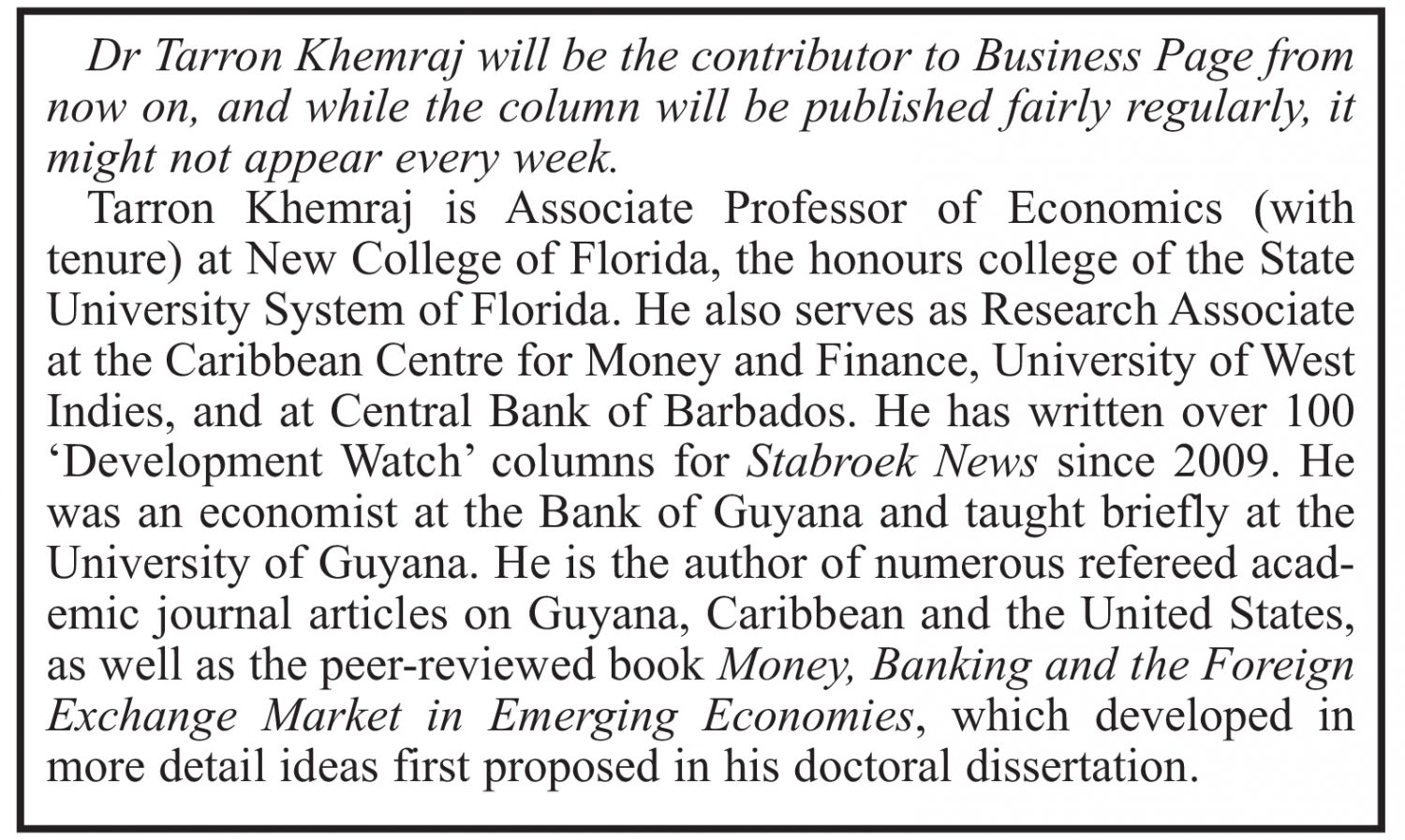 The 2018 national budget outlines snippets of a broader economic vision, the Green State Development Strategy (GSDS), which somewhat underpins this budget and will likely do so for future APNU+AFC budgets. The budget statement of Minister Jordan declares that the amorphous GSDS is intended to form a coherent blueprint document of the government’s development objectives, which it sees will impel Guyanese on the “Journey to the Good Life”. Page 19 of the budget speech outlines seven central themes, pillars of sort, of the GSDS. These are (i) green and inclusive structural transformation; (ii) sustainable management of natural resources and expansion of environmental services; (iii) energy – transition to renewable and greater energy independence; (iv) resilient infrastructure and spatial development; (v) human development and well-being; (vi) governance and institutional pillars; and (vii) international cooperation, trade and investment.
The 2018 national budget outlines snippets of a broader economic vision, the Green State Development Strategy (GSDS), which somewhat underpins this budget and will likely do so for future APNU+AFC budgets. The budget statement of Minister Jordan declares that the amorphous GSDS is intended to form a coherent blueprint document of the government’s development objectives, which it sees will impel Guyanese on the “Journey to the Good Life”. Page 19 of the budget speech outlines seven central themes, pillars of sort, of the GSDS. These are (i) green and inclusive structural transformation; (ii) sustainable management of natural resources and expansion of environmental services; (iii) energy – transition to renewable and greater energy independence; (iv) resilient infrastructure and spatial development; (v) human development and well-being; (vi) governance and institutional pillars; and (vii) international cooperation, trade and investment.

It is a very good idea that the government has finally decided that it should pin down its short-term annual budget policies with a comprehensive medium and long-term development vision. Several Development Watch columns, which I have written since 2009, have made this exact point that annual budget spending, taxation, wage policy, transfer payments to the vulnerable, borrowing, etc, cannot be done in an ad hoc manner and disjointed from one year to the next. Instead, they must be underpinned by a coherent set of long-term objectives and targets, which show a continuity of the vision.
An important question arising is whether the APNU+AFC government will be able to pull off an inclusive development strategy given that the constraints and political reality are severe. My task is not necessarily to answer this question, but to provide a review of the snippets provided by budget 2018. Given that the annual budget is a one-period iteration of a multiple-period development programme, I am not certain the budget is the place to outline this grand vision. Nevertheless, we work with what we have: budget 2018 is the first explicit outline that a long-term development plan is in the works.
In keeping with the fact that this essay is meant for Business Page, the natural thing to do is start with what the budget has to say about the business sector. The budget presentation dedicated two pages to business and investments. The government continues the PPP’s agenda of developing the Lethem Industrial Estate and Belvedere Industrial Estate.
A lot is made of small business development in Guyana, I guess partly because the market size does not exist for many small businesses to grow up and become large oligopolies like Banks DIH or DDL. The latter giants are known for their supernormal profits, high levels of employment, and overall sterling contributions to the country. Small businesses, as important as they are, tend to have slim profit margins and will most likely stay small given the dispersed and tiny population of Guyana. The Lethem Industrial Estate is meant to serve the Brazilian market. Bon Fim, on the Brazilian side of the border, has a population of just under 13,000 people dispersed over a fairly large geography. However, Manaus is about 11.5 hours drive from Lethem or approximately 855 km. It has a population of about 2.1 million people with a different culture compared with our coastal Caribbean sensations.
The budget notes that Go-Invest facilitated around $23 billion in investments, which are expected to create 970 jobs. However, we must note that Go-Invest is not the official statistical agency for labour market surveys. As a matter of fact, the labour market is still a mystery in Guyana. We are not only unaware of the unemployment rate (decomposed into its frictional, seasonal and cyclical components), but also the labour force participation rate. In fairness to Minister Jordan, however, he is certainly aware that a serious development plan requires data and the human capacity to analyse them. Let’s see whether the first labour market survey is ready next year as the budget anticipates. Go-Invest cannot be seen as the authority on the employment situation in Guyana because we have to count both jobs created and jobs destroyed during the natural churning of the economy. The politicians are always incentivised to tell us only about the ones created. We have to always keep an eye on the net outcome as we ponder the GDP growth rate.
The way the budget presents the government’s long-run economic vision makes it appear that policy objectives such as (i) macroeconomic stability, (ii) better governance, (iii) better government and (iv) emerging transformative sectors are on the same level as the GSDS. These are presented as being horizontal to each other and the GSDS. None is a subset or important plank of the GSDS. The natural question arising from this outline is whether some of these conflict. So, for example, does the imminent oil and gas sector conflict with GSDS? And how might they be reconciled? The budget provides a faint answer to the latter. Oil revenues will be used to invest in renewable energy sectors.
Macroeconomic stability involves mainly debt management strategy, according to the budget. What I find curious is the government appears unwilling, as did previous regimes, to disentangle debt in foreign currencies and those in Guyana dollars. I am aware the IMF likes to group them together, but could we think for ourselves? It is obvious debt in foreign currencies is potentially a bigger problem. Moreover, when do we know whether debt management is consistent or inconsistent with the objectives of GSDS?
The budget presentation gives the impression that not everyone in the APNU+AFC government fully appreciates the crucial importance of stable macroeconomic forces. While humans live microeconomic lives, downward causation from the macro to the micro determines the circumstances under which people make choices or live their individual lives. When the Guyana dollar was devalued from 1988 to around 1991, many in the middle class became poor overnight. Long pension expectations evaporated over a few days.
It is heartening to read that the APNU+AFC administration sees better government and better governance as part of its wider vision. However, it is not clear from the budget whether these should be important pillars of a wider development agenda. The budget presents public procurement and the Public Sector Investment Programme as instruments of better government. It would be interesting to see whether a deeper understanding of better government will come out from Congress Place as the GSDS evolves. In particular, an understanding that envisions an independent, meritocratic and competent public service which is headed by a career professional rather than a hard-core politician like Dr Luncheon or Mr Harmon. I doubt whether Congress Place will have the courage to go that deep.
The budget sees better governance as encompassing constitutional reform, local government systems, justice reforms, anti-money laundering and social cohesion. The budget does not provide a hint that APNU+AFC sees constitutional rewriting as a crucial tool for engendering social cohesion. I personally do not see how social cohesion can be built within the structures of the present constitution that entrenches distrust and incentivises subliminal messaging at election time. Constitutional overhaul can be seen as a credible commitment for solving an information problem between two dominant groups.
Governance and government are certainly crucial factors that influence business activity, perceptions of fairness in business procurement, and ultimately the risk premium an investor builds into her discount rate as she contemplates a future private investment. Therefore, politics cannot be removed from business policies. We will have to develop this theme in the next column as we analyse the budget, which in a rudimentary manner makes the point that business and politics are related.
Comments: [email protected]





